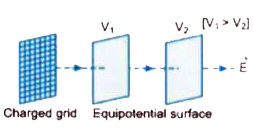Describe schematically the equipotential surfaces corresponding to
(a) a constant electric field in the z-direction,
(b) a field that uniformly increases in magnitude but remains in a constant (say, z) direction,
(c) a single positive charge at the origin, and
(d) a uniform grid consisting of long equally spaced parallel charged wires in a plane.
We know that an equipotential surface is always perpendicular to the direction of electric field lines. Hence,
(a) For a constant electric field in the z-direction, equipotential surfaces are planes parallel to x-y plane as shown in Figure.
(b) For a filed in z-direaction increasing uniformly in magnitude, equipotential surfaces are planes parallel to x-y plane. However, planes differing by a fixed potential get closer as the electric filed increases figure.
(c) For a single positive cahrge at the origin, equipotential surfaces are concentric spheres with origin as their centre.
For a uniform grid consisting of long equally spaced parallel charged wires in a plane,equipotential surface at large distances are planes parallel to the grid. However, very near the grid the equipotential surfaces have curved shapes due to edge effect.

Topper's Solved these Questions
- ELECTROSTATIC POTENTIAL AND CAPACITANCE BOOK - U-LIKE SERIESCHAPTER - ELECTROSTATIC POTENTIAL AND CAPACITANCE EXERCISE - CASE BASED/SOURCE-BASED INTEGRATED QUESTIONS
18 Videos
- ELECTROSTATIC POTENTIAL AND CAPACITANCE BOOK - U-LIKE SERIESCHAPTER - ELECTROSTATIC POTENTIAL AND CAPACITANCE EXERCISE - MULTIPLE CHOICE QUESTIONS
35 Videos
- ELECTROSTATIC POTENTIAL AND CAPACITANCE BOOK - U-LIKE SERIESCHAPTER - ELECTROSTATIC POTENTIAL AND CAPACITANCE EXERCISE - SELF ASSESSMENT TEST
1 Videos
- ELECTROMAGNETICE INDUCTIONBOOK - U-LIKE SERIESCHAPTER - ELECTROMAGNETICE INDUCTIONEXERCISE - Self Assessment Test Section -D
1 Videos
- EXAMINATION PAPER 2020 (SOLVED)BOOK - U-LIKE SERIESCHAPTER - EXAMINATION PAPER 2020 (SOLVED)EXERCISE - SECTION D
6 Videos
Similar Questions
Describe schematically the equipotential surfaces corresponding to
(a) a constant electric field in the z-direction,
(b) a field that uniformly increases in magnitude but remains in a constant (say, z) direction,
(c) a single positive charge at the origin, and
(d) a uniform grid consisting of long equally spaced parallel charged wires in a plane.
View SolutionDescribe schematically the equipotential surfaces corresponding to
A single positive charge at the origin.
View SolutionDescribe schematically the equipotential surfaces corresponding to
A single positive charge at the origin.
View SolutionDescribe schematically the equipotential surfaces corresponding to
A field that uniformly increases in magnitude but remains in the same (say Z) direction
View SolutionDescribe schematically the equipotential surfaces corresponding to
A field that uniformly increases in magnitude but remains in the same (say Z) direction
View Solution(a) Draw the equipotential surfaces corresponding to a uniform electric field in the z-direction.
(b) Derive an expression for the electric potential at any point along the axial line of an electric dipole
View Solution(a) Draw the equipotential surfaces corresponding to a uniform electric field in the z-direction.
(b) Derive an expression for the electric potential at any point along the axial line of an electric dipole
View SolutionDraw 3 equipotential surfaces corresponding to a field that uniformly increases in magnitude but remains constant along positive Z-direction. How are these surfaces different from that of a constant electric field along Z-direction ?
View SolutionDraw 3 equipotential surfaces corresponding to a field that uniformly increases in magnitude but remains constant along positive Z-direction. How are these surfaces different from that of a constant electric field along Z-direction ?
View SolutionDraw 3 equipotential surfaces corresponding to a field that uniformly increases in magnitude but remains constant along Z-direction. How are these surfaces different from that of a constant electric field along Z-direction ?
View Solution
